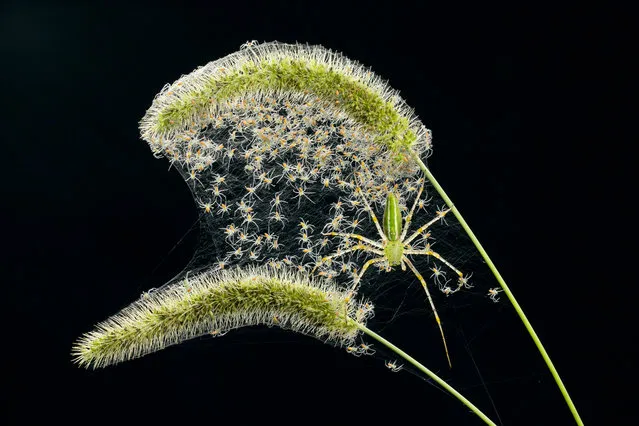
“Peucetia formosensis”. July to October each year between Peucetia formosensis Mum Will yield about 300 more than just a small Peucetia formosensis Very spectacular surprise. Photo location: Taiwan. (Photo and caption by 富美 賴/National Geographic Photo Contest)
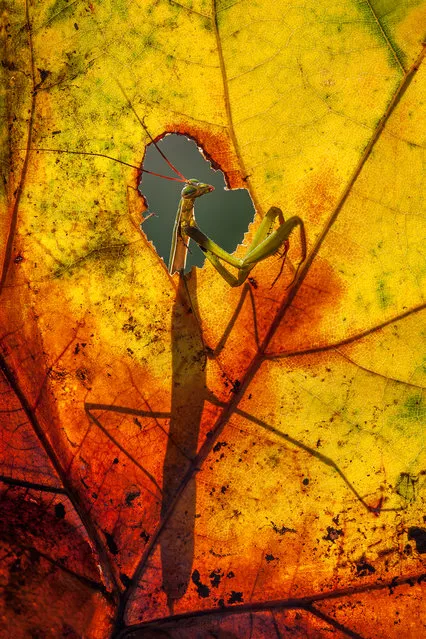
“On window enjoying the Autumn”. This was a beautiful and funny scene, at the same time, definitely unique and singular moment. I was amazed when I saw the shadow of the mantis on the leaf, and then my astonishment at seeing it coming out of the window with that cute little face. I don’t know what the Mantis was doing but I like to imagine it was enjoying on the “window” the autumn with its beautiful colors. Photo location: Paliano Reserve, Rome, Italy. (Photo and caption by Alberto Di Donato/National Geographic Photo Contest)
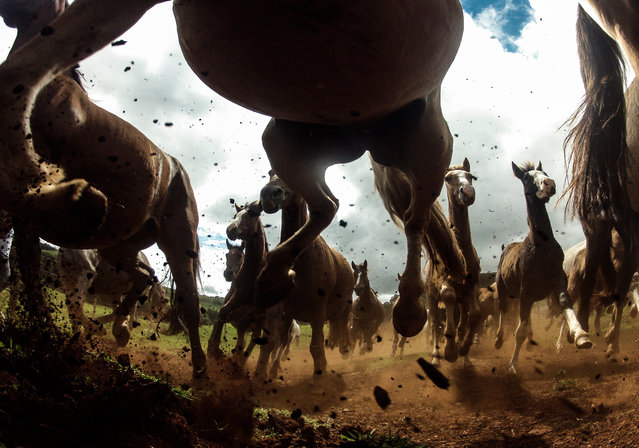
“The Power of the Criollos”. The power of the Criollo horses at the Cabanha Ipuã located in Paranà, Brazil. The Criollo is the native horse of Uruguay (1910), Argentina (1918), Brazil (1932) and Paraguay. It may have the best endurance of any horse breed in the world next to the Arabian. Photo location: Parana, Brazil. (Photo and caption by Chris Schmid/National Geographic Photo Contest)
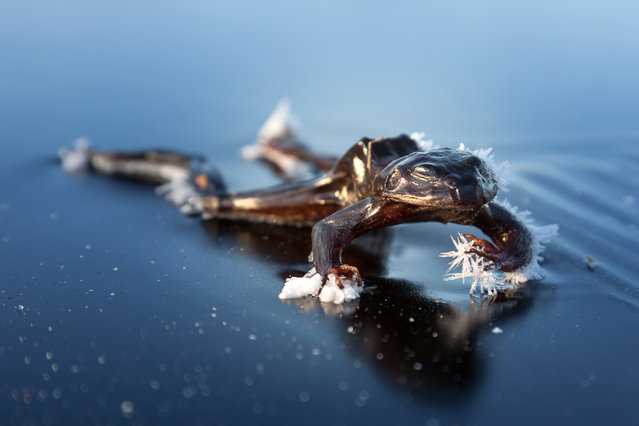
“Frozen Frog”. After some days with temperatures below freezing point, I was out skating at some lakes at the outskirts of Oslo in Norway. After a while I noticed something on the ice. To my astonishment it was a dead frozen frog. Photo location: Bindingsvannet, Norway. (Photo and caption by Svein Nordrum/National Geographic Photo Contest)
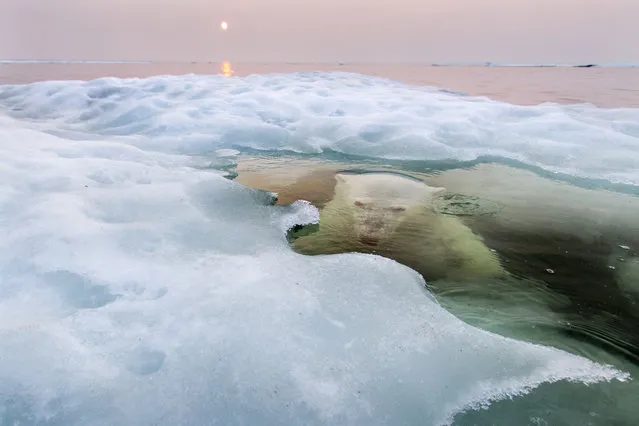
“The Ice Bear”. A polar bear peers up from beneath the melting sea ice on Hudson Bay as the setting midnight sun glows red from the smoke of distant fires during a record-breaking spell of hot weather. The Manitoba population of polar bears, the southernmost in the world, is particularly threatened by a warming climate and reduced sea ice. Photo location: Hudson Bay, Manitoba, Canada. (Photo and caption by Paul Souders/National Geographic Photo Contest)
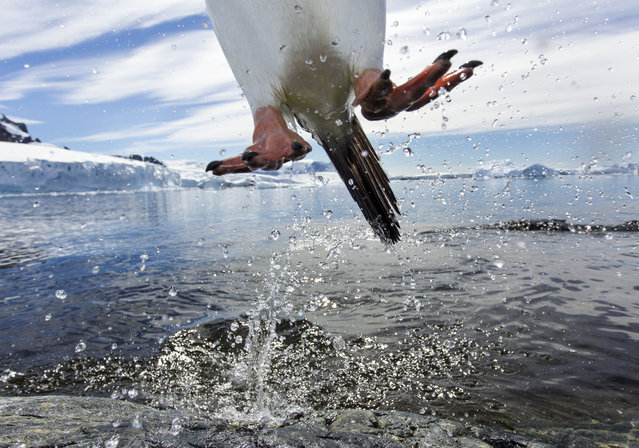
“Leaping Penguin, Antarctica”. A Gentoo Penguin (Pygoscelis papua) caught in midair while leaping from water onto Cuverville Island's rocky shoreline along the Antarctic Peninsula. Though flightless, penguins can still launch themselves through the air to avoid leopard seals that may lie in ambush near their rookeries. Photo location: Cuverville Island, Antarctica. (Photo and caption by Paul Souders/National Geographic Photo Contest)
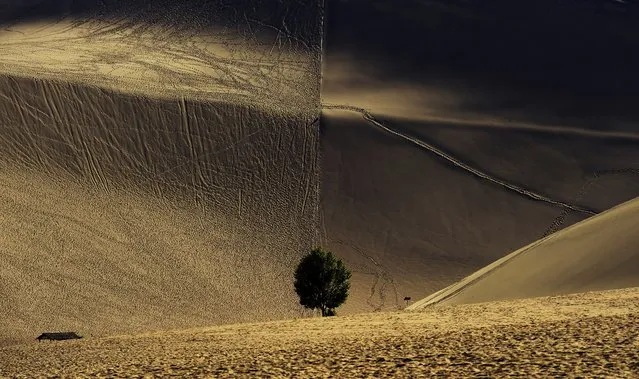
“The Quiet Desert”. The situation of the desert on left side of this picture was made by footprints of tourists shapes sharply contrast with those on right side in which do not allowed visitors to enter in order to protect the Crescent Spring. Photo location: Dunhuang, Gansu Province, China. (Photo and caption by Kate Xiao/National Geographic Photo Contest)
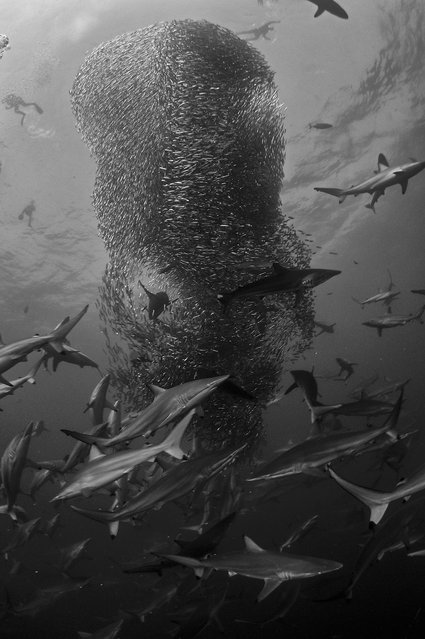
“Vortex”. The Sardine Run is considered to be one of the most spectacular wildlife events. The search for dive-able bait ball action can be long and hard, with no guarantees of being in the right place at the right time. Jumping into the water on a unique bait ball is a once in a lifetime luck. This bait ball, later christen, the Shark Ball was a phenomenal sight. Normally a the bait ball will escape fairly easily without the presence of dolphins, but the shear number of sharks, created a grid so tight around the ball, that each and every one of the bait fish got eaten. Photo location: Port St. Johns, South Africa. (Photo and caption by Geo Cloete/National Geographic Photo Contest)
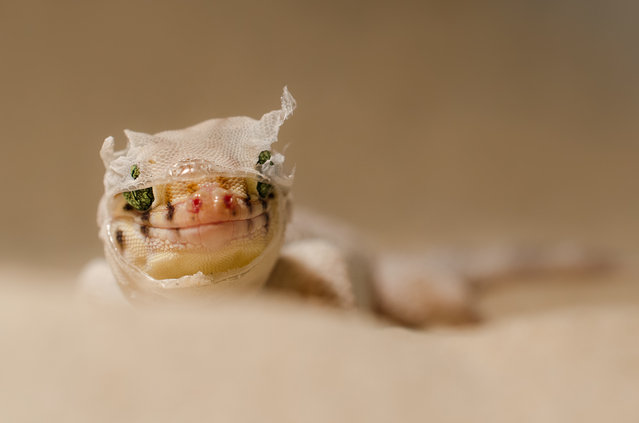
“Chinese wonder gecko (Teratoscincus roborowskii)”. A gecko who just shed his skin looks surprised into the lens, what could that be? Photo location: Terrarium, Ulm, Germany . (Photo and caption by Gabriel Ozon/National Geographic Photo Contest)
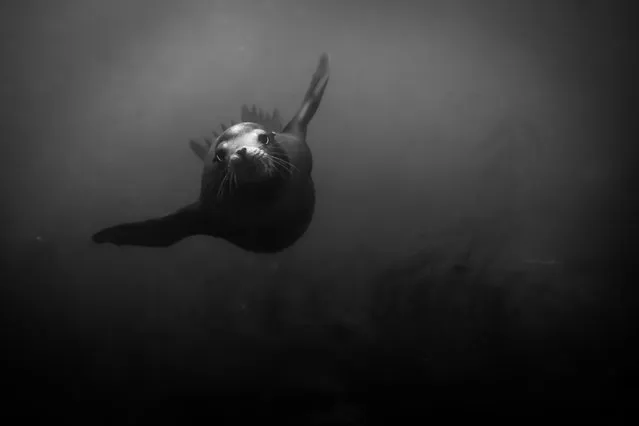
“Fly By”. A California sea lion makes a gentle pass to reward her curiosity. Photo location: La Jolla, Califonia. (Photo and caption by Ralph Pace/National Geographic Photo Contest)
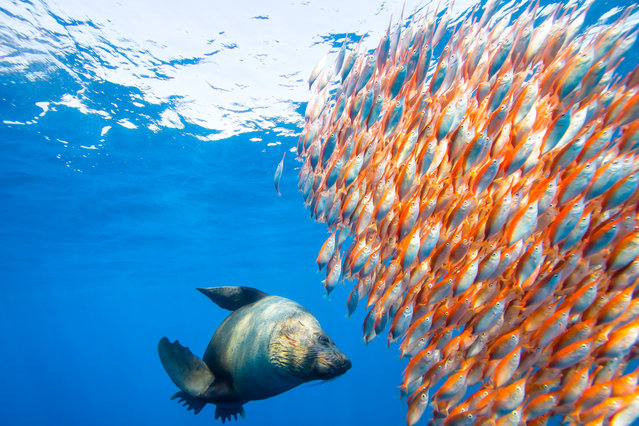
“Rounding up the bait”. We spotted 7 whales leisurely making their way South but the highlight of the day was this fur seal and the bright orange bait ball. He would skillfully heard the fish up like a cattle dog before busting through the ball taking one unlucky candidate at a time. We watched him do this for over an hour, it was amazing. Photo location: Sydney, Australia. (Photo and caption by Mark Seabury/National Geographic Photo Contest)
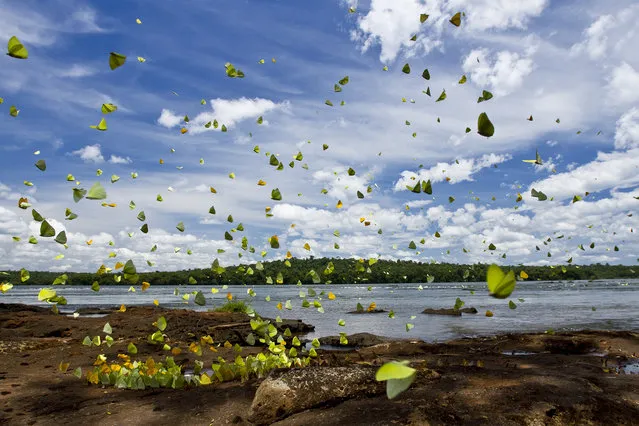
“Tornado of color”. Large gatherings of butterflies are common alongside Iguaçu River (Brazil/Argentina border) When the river flow gets lower, the rocky riverbanks become exposed retaining water in small pounds, very rich in salts. This attracts butterflies of several species, mainly from Pieridae Family. Butterflies absorve and concentrate the salts in their bodies, pumping out the excess water. Photo location: Iguaçu, Paraná, Brazil. (Photo and caption by Daniel Pinheiro/National Geographic Photo Contest)
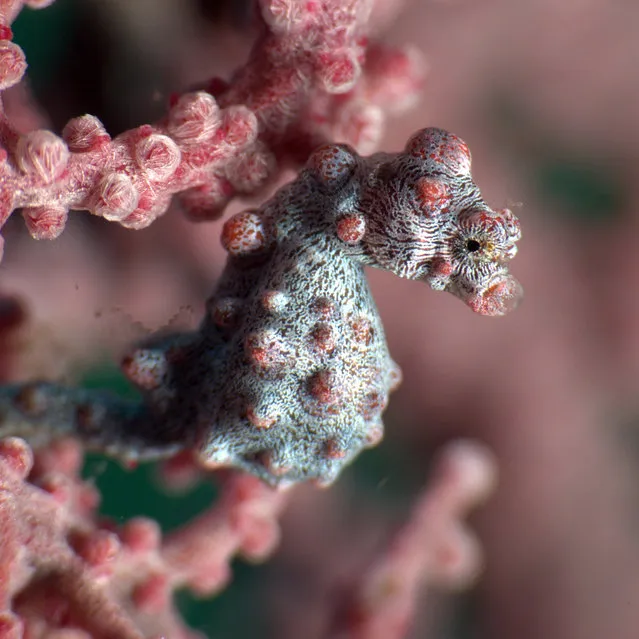
“Smaller Than Small”. A tiny Pygmy Seahorse allows my intrusion. Photo location: Anilao, Philippines. (Photo and caption by Jonathan Lavan/National Geographic Photo Contest)
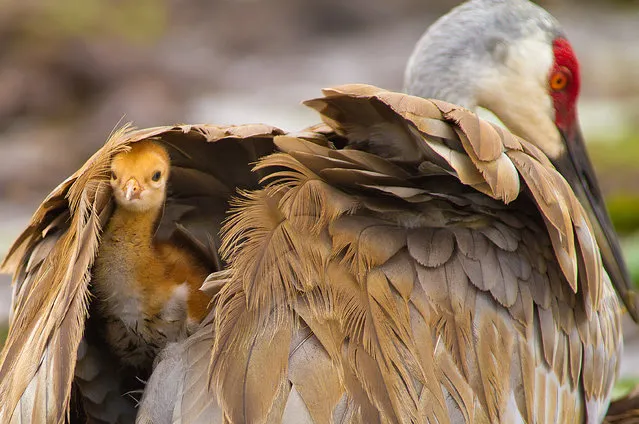
“Hiding In The Shadows”. This Baby Sandhill taking refuge under Moms wings while sitting on her second egg. I witnessed this baby being born earlier that day,and the next morning saw the other one hatch,what a sight to see. Photo location: Deland, Florida. (Photo and caption by Scott Helfrich/National Geographic Photo Contest)
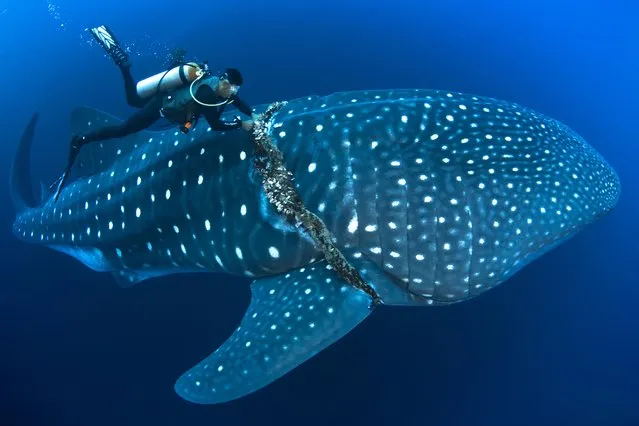
“Rescue”. A Whale Shark was found wrapped with a thick line around its midsection. A Divemaster struggles in strong current at more than 100ft. to free the 35 ft.shark from the line. Eventually he succeeded and the whale shark was freed. Photo location: Roca Partida, Mexico. (Photo and caption by David Valencia/National Geographic Photo Contest)
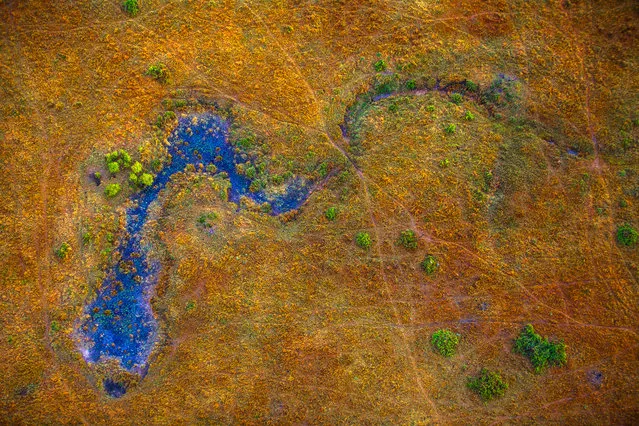
“Were we Belong”. While I was in the ballon above Mara, I saw this great composition of water and land. Photo location: Masai Mara, Kenya. (Photo and caption by Mohammed Yousef/National Geographic Photo Contest)
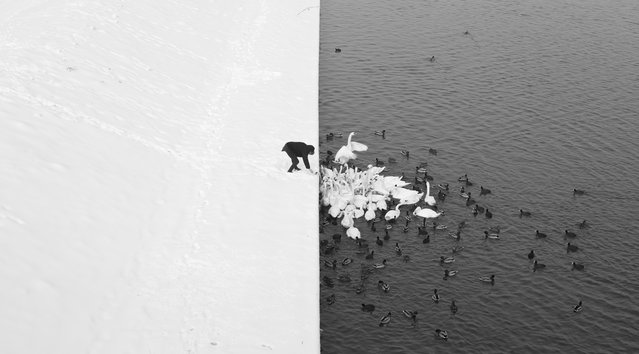
“A Man Feeding Swans in the Snow”. Photograph was taken in Cracow from Grunwald Bridge. Contrast created by a nature of white snow and dark water separated by a line equal to the waterfront is a graphical reflection of the Yin-Yang symbol – opposing but complementary forces. The dark silhouette of a man on a light background and white swans on the dark water, surrounded by a ring of black ducks, compose complementation of the image, thereby giving it many possibilities of interpretation. Photo location: Cracow, Poland. (Photo and caption by Marcin Ryczek/National Geographic Photo Contest)
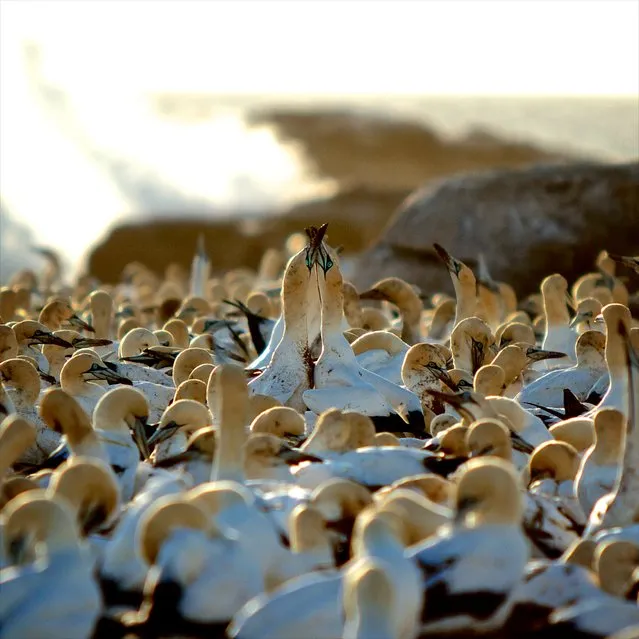
“Cape Gannets in Love”. Two Cape Gannets entwined in an embrace at Lambert's Bay, South Africa. Photo location: Bird Sanctuary at Lambert's Bay, South Africa. (Photo and caption by Jon Eickmeier/National Geographic Photo Contest)

“Fire in the sky”. I took this photo at sunset in September at White Sands, New Mexico. It was a beautiful evening with the light changing as it got closer to sunset, but none of us expected the magnificent orange sky that appeared immediately after the sun set. Photo location: White Sands National Monument. (Photo and caption by Chris Gattuso/National Geographic Photo Contest)
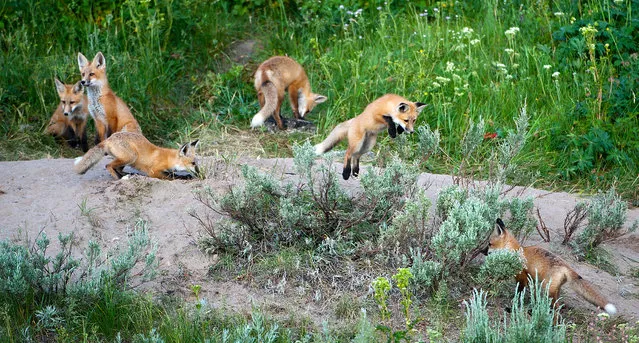
“Morning Frolics!” This Fox family had their den just down the way a bit from my cabin. On this particular day, everyone was out enjoying an early morning romp. There is action everywhere here!! One kit leaps an another is busy sneaking up on him. There were so many things happening, it was hard to keep up with it all. And, two of the kits didn't even get in this image! With each kit seemingly going a different direction, the mom patiently sits and watches, ensuring everyone is safe during the morning frolics. Photo location: Henry's Lake, Idaho. (Photo and caption by Jon Jacobs/National Geographic Photo Contest)
08 Dec 2013 11:51:00,
post received
0 comments
